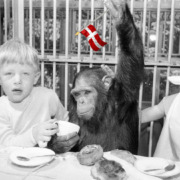Tivoli vs Bakken: How two amusement parks show the two sides of Denmark
It’s spring in Denmark. The sunny days are longer, the daisies are popping up through the grass, and the sidewalk cafés are full again, even if you have to sit there with a blanket, which many cafés provide.
And Denmark’s amusement parks are opening up for the summer. Denmark has several amusement parks, including the original Legoland, but the ones I know best are the ones in Copenhagen – Tivoli Gardens and Bakken.
Tivoli and Bakken show two different sides of the Danish character.
Tivoli is the sleek, confident, high-end image that Denmark likes to present to the world: it has exquisite flower gardens, fancy shops and restaurants, and a theater that hosts world-class performers. Bakken is more homey, more quirky, a little shabby, and a bit more hyggelig, under my own definition of hygge as “unambitious enjoyment”.
The difference between the two parks also illustrates the class differences in Denmark – even though Danes like to pretend there are no class differences in egalitarian Denmark.
Visiting Bakken
Bakken is clearly the more working-class of the two and opens every year with a huge convoy of thousands of motorcycles roaring through the city. It happens every April – I hear a huge mechanical growl in the distance, and then I realize, ahhhhh, Bakken is opening today.
When you arrive at Bakken, you’re greeted by higgledy-piddledy old wooden houses in various stages of repair, home to arcade games or fast food vendors serving hot dogs or shawarma, or restaurants with all-you-can-eat pork chops.

The wooden rollercoaster at Bakken
Bakken’s rickety wooden rollercoaster has been around since 1932, and it seems like a good way to risk your life. For the less adventurous (or foolhardy), Bakken offers the tiny “ladybug” rollercoaster, which is the very first carnival ride for generations of Danish children.
Bakken is old – in fact, it calls itself the world’s oldest amusement park. It dates back to 1532, even before this area was the king’s deer hunting grounds. Those hunting grounds are still there, a huge forest of giant oak trees right outside of Bakken, where you can picnic today and still see deer peeping out from behind the trees.
The Danish royal family does still occasionally hunt there. But they shoot only selected deer, usually older ones, whose days are numbered anyway.
Visiting Tivoli
Royal or not, if someone was visiting Denmark for only one night, I would send them to Tivoli Gardens, not to Bakken.
Tivoli in downtown Copenhagen is a great non-disappointing tourist attraction, unlike, for example, the Little Mermaid. Tivoli is beautiful, and it’s clear that an army of gardeners, architects and set decorators are at work very hard to make sure it stays that way.
Tivoli actually redecorates itself several times per year. There is Easter Tivoli, summer Tivoli, Halloween Tivoli, and Christmas Tivoli. Each means new shops, new food, sometimes new rides. Fall means the annual giant pumpkin contest, winter means traditional Danish Christmas treats.
And summer means Friday Rock concerts on the big grassy field at the center, concerts that are extremely popular with Danish teenagers. Tivoli is not just for tourists. Many locals get an annual pass.
Tivoli is ambitious
Now, Tivoli is a very ambitious enterprise. It is always introducing exciting new carnival rides, and it was recently reported that the amusement park was looking to add a Michelin star restaurant. Its current restaurants vary in quality, although they don’t vary much in price – they’re all expensive.
And while Bakken has its forest of deer – natural deer, just living in the forest and reproducing as deer do – Tivoli has peacocks. Real peacocks, beautiful peacocks, just randomly walking around the grounds.
This has always seemed to me like a great example of Danish trust. If you had those peacocks walking around in New York City, where I used to live, someone would take them home the first day and make them into peacock soup.
Tivoli vs Bakken
None of this is free, of course. At Tivoli, adults pay Dk145 ($21) just to enter the park, rides not included. Just to walk in the door. A pass to enter and to go on all the rides for the day will set you back 429 Danish kroner, or about $60.
Entrance to Bakken, on the other hand, is entirely free. You can just roll up on any spring or summer day, on your motorcycle or on the bus, with your picnic lunch if you like.
Put a blanket down under the oak trees in the forest, and before you try out the carnival rides, enjoy the most beautiful seasons of nature in Denmark.





